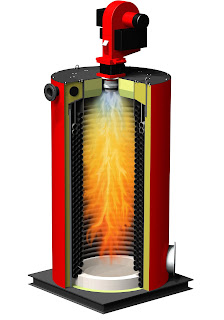A heater is a recipient constituted basically by a furnace in which a heat transfer fluid is warmed up, from an energetic source that can be a liquid, gaseous, solid fuel or doughy like the glycerine, warm smokes or electricity.
They exist different designs from heaters, although the most common it usually uses conventional power sources as liquid or gaseous fuels and it consists of a furnace which lodges:
They exist different designs from heaters, although the most common it usually uses conventional power sources as liquid or gaseous fuels and it consists of a furnace which lodges:
- in its perimeter: coils (according to the design of each manufacturer they can be 1, 2 or 3 coils) through which flows a heat transfer fluid,
- and in the centre, a flame produced by an external burner, source of heat transfer by convection.
In this type of heaters, the burner will be installed as a main and necessary source of heat to warm up the fluid that will contribute to heat to machines or external consumers. The burner will fix the thermal power of the heater, which will have to be designed to support it.
Another important and also external element to the body of the heater, it is the pump of impulsion of the fluid that we are warming up. The pump also serves to maintain a constant movement of the fluid inside the coils of the furnace and in the circuit, as well as to send it warms up until each consuming machine.
As far as the used fluid, this one has a double thermodynamic function: Its passage by the coil of the furnace contributes to the cooling of the coil, which yields its heat to the oil in return: A thermal exchange takes place. For that reason the preferred design for the thermal oil heaters is the aquotubular, that it assures a constant circulation, and not the pyrotubular one.
The thermal oil heaters, thanks to this fluid and to the fact that its heating it does not imply a change of phase, work at very low pressures being able however to reach normal service temperatures from 280 to 300ºC. Another important characteristic which defines them, it is the global high efficiency of the installation that usually oscillates between the 87 and 90%, based on the working temperatures.
In our next blog, we will speak about electrical thermal oil heaters.






0 comments:
Post a Comment